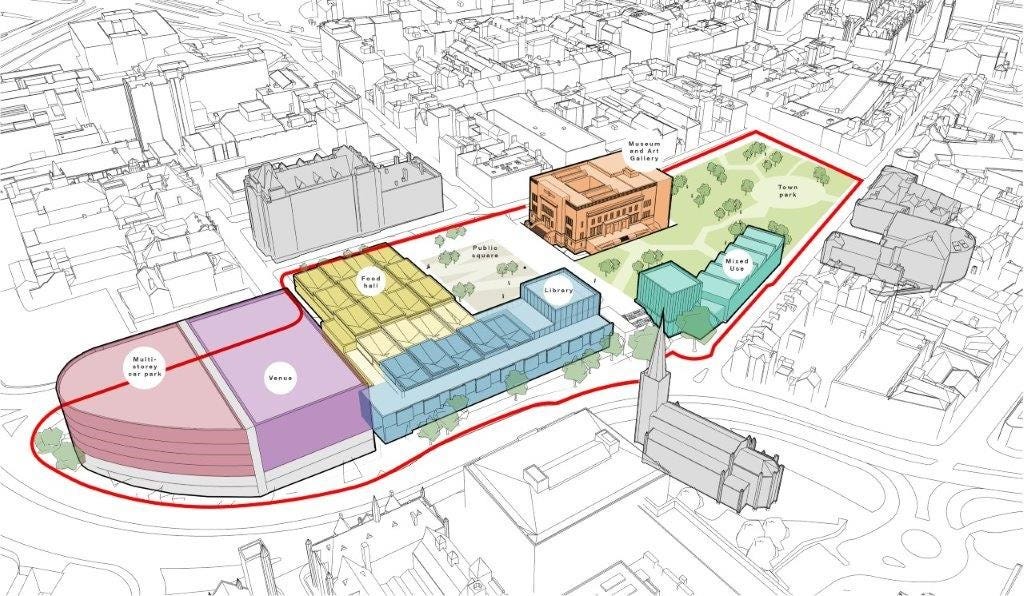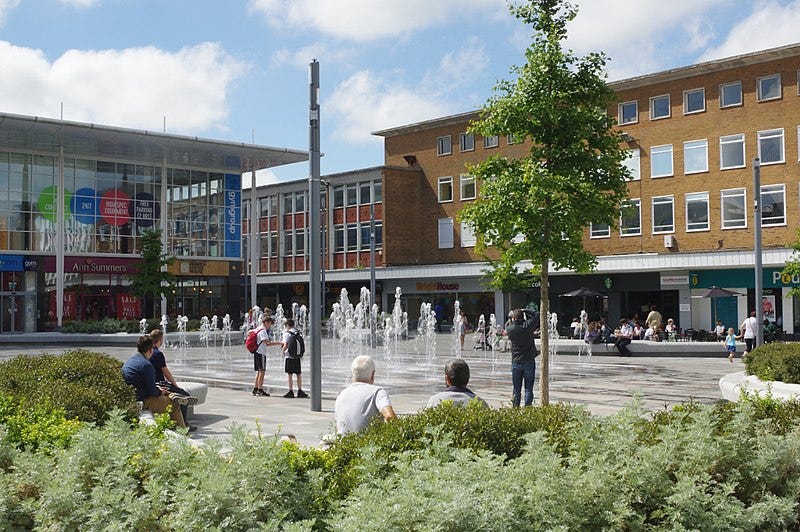Happy springtime and all that.
Parish notices from me:
quite a few events this spring in Sussex - all focused on local economies and culture and how to navigate change. Would love to see you there » alwayspossible.co.uk/events
And here’s a picture of a dog, that just peers over a high wall at the end of my road, judging people walking by. The look, the hair, everything about it is brilliant.
Anyway.
What is a cultural quarter?
Unsurprisingly, a cultural quarter is a designated area within a city that concentrates creative and cultural industries, such as art galleries, theatres, music venues and museums. Really, this is a form of zoning for urban regeneration - in order to stimulate economic growth, revitalise underused areas, and enhance the cultural vibrancy of a city. It’s fairly Ronseal, as naming conventions go.
The concept gained prominence from the 1980s onwards, particularly in the USA and Europe, where cities deliberately and transparently planned these zones to attract tourism, encourage economic investment and create jobs.
Key to any ideas around this is that it is not just focused on consumption — where people attend shows, visit galleries, and participate in events — but also for cultural production, providing spaces for artists, designers, and other creatives to produce their work. A commercial cycle of create - make - sell.
Examples:
Leicester
The area in the centre of the city, focused around the Curve Theatre and the Phoenix Cinema.
Brighton
The North Laine spilling onto the Royal Pavilion, Museum & Art Gallery and Brighton Dome - but encompassing street art trails, the Toy Museum, Theatre Royal.
Southampton
The area around Guildhall Square is home to the O2 Guildhall, the Stage Door, Southampton City Art Gallery, SeaCity Museum, John Hansard Gallery (Studio 144), and MAST Mayflower Studios.
Liverpool
William Brown Street has a remarkable concentration of public realm and amenities, including the William Brown Library and Museum, World Museum Liverpool, Liverpool Central Library, Walker Art Gallery, and St George's Hall.
Northampton
The quarter here has been more recently engineered around the Royal & Derngate theatre complex, Northampton Museum and Art Gallery, 78 Derngate—a historic house designed by Charles Rennie Mackintosh—and the Errol Flynn Filmhouse.
Birmingham
The once pretty miserable Digbeth now offers Digbeth Dining Club, the monthly Digbeth First Friday, and annual festivals like Supersonic and the Flatpack Film Festival. The area also features the Custard Factory, a collection of independent businesses located in restored Victorian factories.
So what?
The point of this blog is to ask how you create a cultural quarter. And what comes first, the culture or the space?
I’ve just finished working on a feasibility study for a cultural quarter in Crawley, West Sussex.
Crawley facts:
The area (28 miles south of London, 18 miles north of Brighton and Hove),has been inhabited since the Stone Age and was a centre for ironworking during the Iron Age. Crawley was established as a market town in 1202.
Located on the northern edge of Crawley, Gatwick Airport is the UK's second-largest airport, and the town's economy and development is intrinsically linked to the airport.
In 1947, Crawley was designated as a New Town, leading to significant expansion and development to accommodate population overspill from London after World War II.
Crawley's economy has experienced significant growth, with a 27% increase since 2022, reaching an annual GVA of £6 billion. This accounts for nearly a quarter of West Sussex's economy, despite Crawley covering only 2% of the county's land area.
The town has an unusually high employment rate of nearly 83%, surpassing both the South East average of 80% and the Great Britain average of 76%.
Crawley has approximately 90,000 jobs, representing 0.3% of all jobs in England. It ranks 27th among non-metropolitan districts in England for total jobs and 7th for job density.
Between 2011 and 2021, Crawley's population increased by 11.2%, from around 106,600 to 118,500. This growth rate is higher than the overall increase for England, which was 6.6% during the same period.
73.4% of Crawley's population identified as White (61.8% White British and 10.5% Other White). Asian communities make up 15.4% of the population, with Indian and Pakistani groups comprising 6.2% and 5.2%, respectively. The town also has a relatively Black origin population at 4.5% and a significant Mauritian community (including most of the exiled Chagos Islanders). It is one of the most culturally diverse towns in the south of England, outside of London.
Once an economic powerhouse, and THE shopping mecca in Sussex, its foundations have been rocked by shifts in industry, retail decline, and the increasing uncertainty of high-street viability.
Crawley’s reliance on aviation and large-scale retail has exposed its vulnerabilities — most notably during the COVID-19 pandemic, when these sectors were hit hardest. It was the worst affected town in England.
Now, Crawley is attempting to redefine itself. But how do you regenerate a town centre in a way that is both economically sustainable and socially meaningful? And how do you strike the right balance between commercial, cultural and community needs?
Can you create something like a cultural quarter when it doesn’t already organically exist, as a catalyst for regeneration?
Since last Summer, I’ve been working with design legend Wayne Hemingway and his son Jack, as well as cultural powerhouse and Crawley arts provocateur Louise Blackwell, to look in to this question.
But as past experiences in towns across England have shown, town centre regeneration is never a simple matter of ‘build it and they will come.’
The lessons emerging from Crawley’s so far shows the wider challenges of town centre revival — and what it takes to get it right.
Here is the brilliant Louise going for a walk.
A diverse town that needs to diversify
Historically, Crawley’s economic success has been driven by its proximity to Gatwick Airport. Aviation jobs, logistics, and service-sector employment have defined the town’s workforce for decades.
But as the pandemic exposed, relying on a single dominant industry carries significant risk. Meanwhile, the retail landscape has seen a steady decline. Changing consumer habits, the shift to online shopping, and the increasing dominance of out-of-town retail parks have left Crawley’s town centre with rising vacancy rates and diminishing footfall. Take a walk around. It’s pretty bleak.
The case for diversification is clear. The local economy needs to broaden its base, reducing its reliance on aviation while strengthening sectors like creative industries, digital innovation, and local enterprise. But diversification is not just about economics — it’s also about liveability. Crawley is already seeing major residential development in the town centre, but simply adding housing without creating compelling reasons for people to engage with the area risks deepening the problem rather than solving it.
A cultural quarter concept can respond to this by positioning culture, creativity, and experience at the heart of the regeneration strategy.
But as our study has been making clear, this isn’t just about inserting a theatre or an art gallery into the mix and hoping for the best. It requires a careful, incremental approach — one that builds capacity over time rather than assuming that demand will instantly follow supply.
And in the current economic and political climate, this is bloody hard.
Lessons from elsewhere: what works, what doesn’t
Crawley is not the first town to attempt this kind of regeneration. Towns like Margate, Sheffield, and bits of forgotten London like Peckham, have all experimented with cultural-led regeneration strategies, with varying degrees of success. Some key lessons stand out:
Organic growth vs. imposed change – Successful regeneration happens when culture and creativity grow organically from what already exists, rather than being parachuted in from above. In places like Margate, cultural regeneration worked because it built on an existing creative community rather than replacing it. In contrast, more top-down initiatives that attempt to impose a cultural identity without strong local roots often fail to attract sustained engagement.
Phasing and experimentation – Large-scale cultural investments that try to ‘solve’ a town centre problem in one go often struggle. Successful models, like Peckham Levels, began with temporary interventions that tested demand and built a case for further investment. Our work in Crawley is trying to follow this logic, proposing a phased “grow it and they will come” model, rather than a single, high-risk intervention.
Integration with local economy – Any place-focused strategy must connect with wider economic needs. In terms of a cultural quarter, this means ensuring that creative workspaces, performance venues, and community hubs are designed not just for cultural activity but for job creation, skills development, and business incubation. Places that have succeeded in this—such as Chester’s Storyhouse — have done so by embedding training, enterprise, and social value into their cultural offer.
Managing risk and ownership – One of the biggest pitfalls in town centre regeneration is placing too much emphasis on capital investment without planning for long-term sustainability. If a cultural space is established without a clear operational and financial model, it risks becoming a burden rather than an asset.
Many failed regeneration schemes have suffered from underestimating running costs, overestimating revenue potential, or failing to secure the right operating partners from the start. The complex landownership in town centres also slows down most development. Like it or not, many landlords would rather sit on an empty high street unit and do absolutely nothing than spend money on it if they don’t need, especially if there is a short term option (hello vape shops) or likely rises in land value that can be cashed in on via a housing development.
A phased model
We think a town like Crawley needs to build its cultural infrastructure carefully, in a way that allows for flexibility, adaptation, and community buy-in. Rather than rushing to create a fully-fledged cultural quarter, the strategy focuses on three core interventions:
Semi-permanent community hubs – Flexible, demountable structures near well-used public spaces that acts as a visible, participatory cultural space. These can provide a home for events, workshops, and community programming, while testing demand for long-term cultural infrastructure.
Creative studios & gallery spaces – Repurposing existing building, especially underused retail or civic spaces, into affordable creative workspaces, rehearsal rooms, and exhibition areas can have a pretty quick multiplier effect - especially if directly linked to public realm.
Outdoor public space activation – Using high footfall public spaces and squares for outdoor events, public art, and communal projects enables something for people to stumble upon. By focusing on flexible, low-cost interventions that animate public spaces, you quickly normalise that culture is happening and becomes a shared and uncontroversial reason for people to visit the high street again.
If successful, igniters like this can act as a catalyst for further investment — whether that’s in dedicated performance venues, more extensive workspace provision, or new cultural and creative business incubation.
The real challenge: sustaining engagement
While a cultural quarter concept has the potential to breathe new life into a lackluster town centre, its success will ultimately depend on sustained engagement — both from local people and from those who have the power to shape investment decisions.
For businesses and landlords, there’s a need to shift perceptions about what drives footfall in a modern town centre. The reality is that retail alone will not bring people back to high streets in the numbers they once did. Cultural, social, and experiential attractions are a growing part of the mix, and businesses that ignore this risk being left behind.
For any council, the challenge is ensuring that momentum doesn’t stall. Short-term funding (like the Towns Fund) can kickstart projects, but long-term viability requires a strategy for governance, investment, and revenue generation. This means working closely with cultural operators, education providers, and private sector partners to ensure that creative infrastructure is supported beyond the initial pilot phase.
For a community, the key question is whether this model genuinely serves local needs. Cultural regeneration can’t just be about making a town ‘attractive’ for external visitors or investors — it has to be relevant to the people who live and work there. That means programming that reflects Crawley’s diverse communities, spaces that are accessible and welcoming, and an approach that genuinely listens to local voices.
But when it works, it really works.








